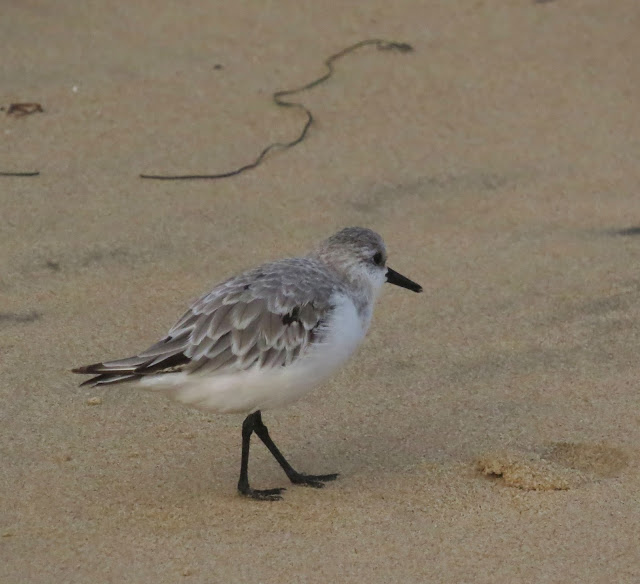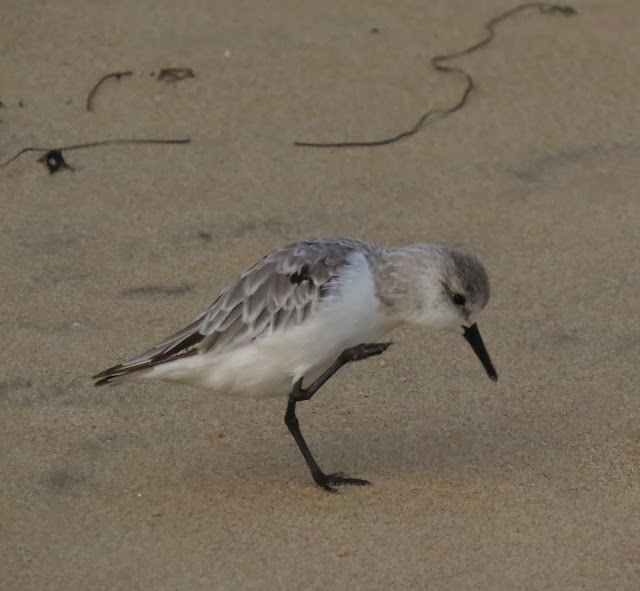I'm still processing through my vacation birding photos. I saved one of my favorite birds to do all at once although we had quite the on-going saga with them throughout the week. I had previously seen ONE
Northern Flicker near my home about a month before this trip, but it was on a terribly overcast day, it was way at the top of a tree and it took off before I had time to take more than one or two shots...all that by way of saying I'd never really got a good look at these beautiful birds before other than in my field guide and other people's terrific photos of them.
So, the first day we were there and I was sitting out on the deck taking shots of the birds at the feeder, I was thrilled to realize that the "knocking" I heard coming from the house next door was not another Acorn Woodpecker, but was, in fact, this gorgeous male Northern Flicker. He was busily engaged in enlarging this hole in the wall of the house. However, before I could even cross to the other side of the deck to move closer...
...he was off! Of course, my shot has that horrible wood deck in the background, but you can still get an idea of how gorgeous these birds are in flight. If you can get a clear flight shot with the sun coming through those wings...they look like they're on fire.
I thought that was going to be it for my encounters with this gorgeous bird, but lo and behold...
...he came back to work on his hole again the next day. This time, I dashed outside and down the stairs to cross the patch of woods between our rental house and the next house so I could get some closer shots...
...I never thought he'd stick around while I maneuvered into position, but there must have been some GOOD bugs in that hole...
...because he hung out for quite a while.
I had mixed feelings about whether I should rat him out to the homeowners - hated for him to lose such a good restaurant, but with rain in the forecast and the size of that hole I also felt bad for the homeowner having to deal with potential water damage. But, since they never were around (most of the properties on the street are vacation and/or rental homes) during our stay...I didn't have to make that decision after all.
The next day, I got a wonderful surprise. He noticed all the activity at our bird feeder and decided to come and check it out. We were eating lunch inside at the kitchen table so I had to shoot through the glass doors in order not to scare him off.
Interestingly, the
Acorn Woodpeckers who, although they clearly dominated the goings on at the feeder, mostly let everyone else come and go with no problem, totally FREAKED OUT when the Flicker approached the feeder.
This railing was the closest he managed to get on this day. Every time he would make a move toward the actual feeder, a Woodpecker would launch itself out of a nearby tree with what I can only describe as a scream of rage and chase him off.
He kept trying, though.
At one point, shortly after I took this shot, he actually landed on the feeder for about a half a second until one of the Woodpeckers performed a birdie body slam (seriously, I heard the "thunk" of bodily contact from inside the house!) and knocked him right off the feeder.
The next day, he wouldn't come any closer than this dead tree at the other end of the deck.
He did a lot of calling from this perch, though. I didn't figure out why until a couple of days later (we left and went down the mountain to another birding spot and then came back).
He called for reinforcements!! That's the female on the right (her face is missing the red marking). By this day, it was raining so I had to shoot from inside which meant the deck railing was a bit in the way.
Here are some close-ups of the female - I cropped out the deck railing.
The rain kept the Woodpeckers somewhat at bay - they were still around, but much less prevalent.
This allowed the Flickers to sneak in and get some suet, finally!
After the rain...we found ourselves inside a cloud bank (we were at the top of a mountain after all). Here's the male "cloud sitting."
Finally, on our last day...we had a brief bit of sun before the clouds closed back in. I found the female sitting on a branch directly overhead.
The male kept watch from a different tree nearby...I think they were really keeping an eye out for the Woodpeckers who had returned in greater numbers during the break in the rain.
These birds truly have some of the most striking markings on their feathers. The black polka dots are awesome!
Finally, it was time to pack up and leave. Watching the spectacle of these different species interacting with each other, the weather, and their mates all week was so informative. I would love to know the REAL reason the Woodpeckers had such a hate on for the Flickers, but I did come up with my own (totally un-scientific) hypothesis. Out of all the species that came to the feeder, the Flickers were the only ones who were 1. ONLY interested in the suet (the others took some of both the sunflower seeds AND the suet) and 2. They had by far the largest beaks and took HUGE amounts per bite. So, whereas the other species all together had worked on the suet all week without making significant inroads on it, the Flickers were at it for a very short time and it was almost gone. I actually replaced it after their short visit.
Hope you enjoyed the Tale of the Flickers!
KJ





















































